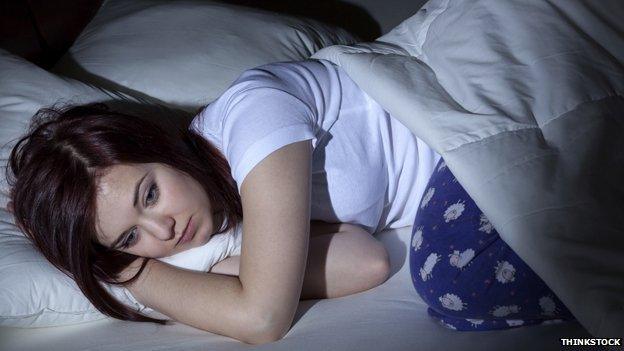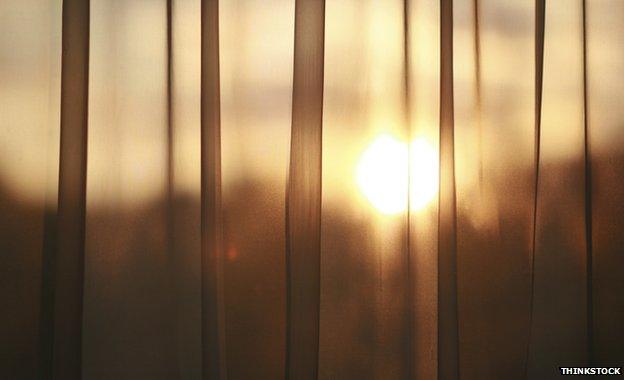The plague of light in our bedrooms
- Published

Researchers warn of the health dangers of too much light while we try to sleep. But how did our bedrooms become so bright?
There are regular warnings that people aren't sleeping properly. Too much light from electronic devices before bedtime. Not enough time in bed. Excessive caffeine. Now there's another potential worry - too much light in the bedroom.
Previous studies have linked light at night with ill health in rodents, external. Now a study of 113,000 women suggests that it could cause obesity in humans. The work by Oxford University researchers for the Institute of Cancer Research found that women had larger waistlines if their bedroom was "light enough to see across", the researchers found.
Prof Derk-Jan Dijk, of the Surrey Sleep Centre, said people "should assess their bedroom and see how easy it would be to make it darker". But have our bedrooms got lighter?
There has probably been a trend towards lighter rooms over the past century, says Alex Goddard, curator at London's Geffrye Museum, which is devoted to the history of the home.
The first problem is more light outside houses. Houses in built-up areas are surrounded by streetlights, car headlights, advertising and other buildings.
The Royal Commission on Light Pollution's 2009 report, Artificial Light in the Environment, warned that in the seven years from 1993 to 2000 significant areas of the UK became more intensively lit at night. The commission noted that outdoor lighting in the UK was growing at an estimated rate of about 3% per annum.
A survey in October 2007 by Harris Poll Europe Omnibus Survey found a third of those interviewed found that light outside bedroom windows led to sleepless nights. The North West of England reported the worst problems with 44% of respondents having difficulties in sleeping because of light pollution.
But as well as the rising amount of light outside our bedrooms, changing home decor trends have exacerbated the problem.
Many people choose lighter curtains and there has been a general move away from curtains to blinds. "In the Victorian period it was all the rage to have very heavy, fulsome curtains," Goddard says. "People liked really luxuriant fabric. Now they don't as it's hard to clean."
Today light spaces with clean lines are desirable.
Guardian interiors editor Ben Spriggs agrees. Blinds have become more popular. And curtains are often thinner. "There's been an increase in linens and sheers, which provide privacy but aren't light-blocking at all." A lot of it is down to money - thin is cheap, he says. There's also a move to clearing away the clutter from windows, which is what blinds do.
At the turn of the millennium blinds represented 25% of the domestic window coverings market, according to Andrew Hartley, director of AMA Research, which conducts research into the construction sector. Now that figure is 30%. By contrast, curtains have fallen back from 52-53% to 47%. Much of that change occurred in the early part of the last decade.
Hartley says that although high-specification window coverings - such as plantation-style shutters, blackout curtains and blinds for skylights - have grown over this period, so too have "lower-quality" goods at the bottom end of the market, fuelled by the rise in the private rented sector.
"The middle part of the market has been squeezed," he says. In short, many people decorating a bedroom may be tempted by window coverings that leave the bedroom in a state of half-light rather than true dark.
And inside the rooms there's a fog of light from electronic devices. How many bedrooms are lit by a series of pinpoints from standby lights? Then there's alarm clocks, digital displays and night lights.

The decor has an amplifying effect. Dark walls are out, says Goddard. Light colours and wallpaper are in, which don't dampen the light. Bedrooms often have bigger windows today, whether from warehouse conversions or new build, she argues.
Property developer Sarah Beeny says she can't sleep unless it's dark. While some parents use blackout curtains for young children, it's rare to find them in adults' rooms, she says. People invest in cheap material, she says. "It's a great shame people's thinking is short-termist - they think we're going to redecorate in a year or two." Her top priority is a good lining when buying curtains, she says.
But not everyone agrees dark is good. Prof Jim Horne, former head of Loughborough University's Sleep Research Centre, doubts light at night causes obesity. People sleep with their eyes shut and can generally ignore what light there is, he argues. It's lighter in the summer than the winter but there's no evidence that people sleep fewer hours, he adds.

Even if people are waking up when it gets light, most people fall asleep again quickly. "The acid test is, are you sleepy during the day?" He suspects there may be other reasons for the obesity correlation. "One has to look at whether sleeping in the dark is a surrogate for something else. Do people who sleep in light rooms have a fear of the dark? Are they more agitated generally?" They could be more susceptible to putting on weight, he believes. More research is needed before people draw any conclusions, he says. "The idea that we should all blacken our room is wrong," he says.
An emphasis on absolutely dark bedrooms could even be dangerous. If it's pitch-black then elderly people getting up in the night might have an accident, Horne says.
The evidence is not yet conclusive. But more studies linking light pollution in bedrooms to problems may prompt people to replace those flimsy blinds with thick curtains. And allow sun-streaked bedrooms once again to become places of solemn repose.
Additional reporting by Jon Kelly
Subscribe to the BBC News Magazine's email newsletter to get articles sent to your inbox.